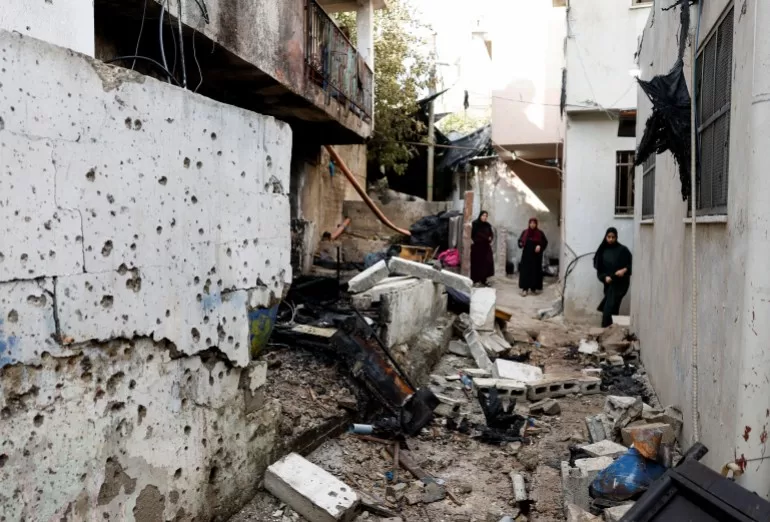Hundreds of Israeli soldiers are conducting a major assault in the occupied West Bank in Jenin, Tulkarem and the Far’a refugee camp near Tubas.
Israeli forces have killed at least 10 Palestinians in what is said to be Israel’s largest assault there in 20 years as they claimed they are targeting “armed terrorists who posed a threat to security forces”.
The Palestinian Authority (PA) presidency condemned Israel’s assault and warned it could usher in “dire and dangerous” results. PA President Mahmoud Abbas returned early from a visit to Saudi Arabia.
Israeli assaults on refugee camps and towns in the West Bank are a near-daily occurrence and have intensified since October 7. The scale of the current attack raises questions about its timing and motives.
October 7 is the date when Hamas launched Operation Al-Aqsa Flood, which killed 1,139 people in southern Israel and saw about 240 taken captive.
Since then, Israel has killed at least 40,534 people and wounded another 93,778 in Gaza.
It has killed 662 Palestinians and injured about 5,400 in the West Bank during that same period.
Pinning the resistance on Iran
In the West Bank, new Palestinian movements have arisen, affiliated with established ones but developing their own strategies against the Israeli occupation after losing patience with the status quo.
On August 19, a suicide attack in Tel Aviv claimed by Hamas seemed to raise concerns in the Israeli security establishment.
“This was a signal that Palestinian groups in the West Bank in clandestine cells are moving toward more offensive action,” Ramallah-based political analyst Abdaljawad Omar said.
He added that the PA “is slowly losing hold over social classes, particularly in the north of the West Bank, coupled with the rise of a new generation of Palestinians that are taking the struggle up on their own terms”.
This may have led Israeli forces to feel the need for “a more proactive offensive strategy”, Omar said.
“Now there is an invasion and offensive action, including arrests, and to reach dense urban areas in the north of the West Bank.”
Israeli Foreign Minister Israel Katz said the assault is “to dismantle Iranian Islamic terror infrastructures” in the areas under attack.
“[Katz] is … not to be taken seriously at all,” political analyst Ori Goldberg told Al Jazeera. “The great thing about [connecting these groups to] the Iran threat is it lets Israel off all hooks.”
Omar dismissed the idea of links between groups in the West Bank and Iran as peripheral at best.
“There are elements of logistical support [for these groups] coming from outside of Palestine,” Omar said, but there are “a lot of indigenous factors behind the rise of these movements”.

Why now and who for?
The recent assault comes as things calm down on another front for Israel.
On Sunday, Israel hit Hezbollah in what it declared a preemptive strike while Hezbollah said it had launched 340 rockets at 11 Israeli military bases.
The two have traded attacks regularly across the Lebanon-Israel border since October 8, which have led to the evacuation of residents of southern Lebanon and Israeli border villages, a situation their inhabitants are growing increasingly frustrated with.
The situation on the Lebanon border has calmed, according to Israel’s allies, but Israel’s war on Gaza continues, even as talks to reach a ceasefire are ongoing. Observers do not hold out much hope for them.
Some analysts believe the assault in the West Bank has been spurred on by right-wing politicians who have increasing power and influence in Israeli society.
Led by National Security Minister Itamar Ben-Gvir and Finance Minister Bezalel Smotrich, this faction is pushing for Israel to go further on the West Bank in what analysts said are efforts to completely annex the land and displace Palestinians.
A statement by Katz on Wednesday that Israel should displace Palestinians living in the northern West Bank just as it does regularly to the people in Gaza has raised fears further on that front.
In recent months, the far right has been vocal about its desire to annex all of the West Bank as it grows stronger under the government of Prime Minister Benjamin Netanyahu, whose coalition relies on Smotrich’s and Ben-Gvir’s support.
Netanyahu has faced several domestic obstacles in recent months, including widespread protests against his rule, scathing criticism from the captives’ families over his lack of action to return their loved ones and increasing frustration from displaced Israelis.
Despite this growing burden and his giving the far right increasing influence, Netanyahu still holds a slight lead in national polls over his main rival for the premiership, Benny Gantz.
“Netanyahu is not a madman,” Goldberg said. “He knows his constituency and his supporters. He knows most Israelis are at a loss in front of the unfolding of events over the past year, … but you will not find a single Jewish Zionist politician who has come up with an alternative political or military vision.”
Israel’s continued fight on multiple fronts is likely to continue, analysts said. Ongoing ceasefire talks over Gaza have hit multiple snags, Israel continues to hit Hezbollah targets and this latest assault is an intensification in an already simmering West Bank.
“There is a continuation to a genocidal logic unfolding in Gaza since October when there is no accountability and impunity is not just a likelihood or a possibility but virtually guaranteed because of the United States’s very specific role in this and to a lesser but still significant extent the EU’s role in all of this,” Elia Ayoub – a postdoctoral researcher, writer and host of the Fire These Times podcast – told Al Jazeera.
